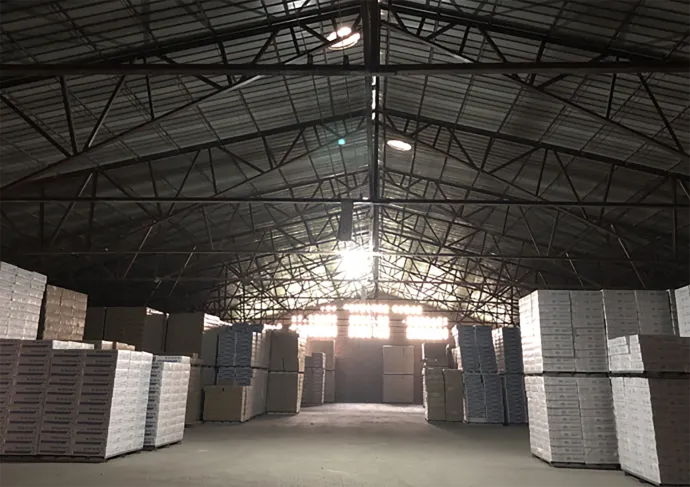- Afrikaans
- Albanian
- Amharic
- Arabic
- Armenian
- Azerbaijani
- Basque
- Belarusian
- Bengali
- Bosnian
- Bulgarian
- Catalan
- Cebuano
- Corsican
- Croatian
- Czech
- Danish
- Dutch
- English
- Esperanto
- Estonian
- French
- German
- Greek
- Hindi
- Indonesian
- irish
- Italian
- Japanese
- Korean
- Lao
- Malay
- Myanmar
- Norwegian
- Norwegian
- Polish
- Portuguese
- Romanian
- Russian
- Serbian
- Spanish
- Swedish
- Thai
- Turkish
- Ukrainian
- Uzbek
- Vietnamese
Pro . 10, 2024 22:33 Back to list
Innovative Design Ideas for Cross Tee Ceiling Systems in Modern Interiors
Understanding Cross Tee Ceilings A Comprehensive Overview
In modern architecture and interior design, ceilings play a crucial role in shaping the aesthetic and functional aspects of a space. Among various ceiling types, cross tee ceilings have gained popularity, especially in commercial spaces, educational institutions, and large retail environments. This article will explore what cross tee ceilings are, their benefits, installation process, and considerations for choosing this type of ceiling for your space.
What is a Cross Tee Ceiling?
A cross tee ceiling, often referred to as a suspended or drop ceiling, consists of a grid system made from metal, which supports lightweight ceiling tiles. The grid is created using main tees that run perpendicular to the building's structural components, while cross tees connect the main tees to form a modular framework. This design allows for easy installation and replacement of tiles, making it a flexible solution for various environments.
Cross tee ceilings are typically found in environments where practicality meets aesthetic appeal. Common materials used for the ceiling tiles include mineral fiber, fiberglass, and metal, allowing for a variety of textures and finishes.
Benefits of Cross Tee Ceilings
1. Design Flexibility One of the primary advantages of cross tee ceilings is their versatility in design. They can be tailored to complement the overall aesthetic of a space, from sleek modern styles to more traditional designs. Additionally, the grid layout allows for the integration of lighting fixtures, HVAC vents, and acoustic panels, enhancing functionality without compromising style.
2. Acoustic Performance In environments where noise reduction is essential, cross tee ceilings can significantly improve sound absorption. Many ceiling tiles are designed with acoustic properties, helping to minimize echoes and noise levels, which is particularly beneficial in schools, offices, and conference rooms.
3. Easy Maintenance and Access Cross tee ceilings provide easy access to ductwork, wiring, and plumbing above the ceiling. This accessibility allows for more straightforward maintenance and repairs, thus reducing costs and downtime associated with ceiling work.
4. Energy Efficiency By incorporating energy-efficient lighting solutions within the grid system, cross tee ceilings can contribute to overall energy savings. LED panels can be easily integrated into the design, providing ample illumination while consuming significantly less energy than traditional lighting.
5. Hiding Imperfections A cross tee ceiling can effectively conceal any imperfections or irregularities in the structural ceiling above. This benefit is particularly appealing in older buildings or spaces where the original ceiling may have damage or wear.
cross tee ceiling

Installation Process
The installation of a cross tee ceiling typically involves the following steps
1. Planning and Measurement Accurate measurement of the room dimensions is crucial. The positioning of main tees and cross tees should adhere to specific standards to ensure structural integrity.
2. Framework Assembly The grid framework is assembled, beginning with the main tees that are attached to wall brackets. Cross tees are then inserted to create a rigid grid.
3. Tile Installation Ceiling tiles are cut to fit as necessary and placed into the grid. This is where the aesthetic aspect comes to life, as various tile designs and finishes can be employed.
4. Finishing Touches Finally, any lighting fixtures or additional components are installed within the ceiling grid, completing the project.
Considerations for Choosing Cross Tee Ceilings
When deciding to install a cross tee ceiling, consider the following factors
- Room Purpose The intended use of the space should guide the choice of ceiling tiles, especially concerning acoustic properties. - Height Restrictions Evaluate the height of the existing ceiling, as a drop ceiling will lower the overall room height. - Budget Constraints Depending on material choices and design complexity, costs can vary. It's essential to plan according to your budget.
In conclusion, cross tee ceilings present a practical, aesthetically pleasing solution for both commercial and residential spaces. With their flexibility, ease of maintenance, and ability to enhance the acoustic environment, they continue to be a favored choice among architects and designers alike.
-
Transform Interiors with PVC Gypsum Ceiling: A Stylish, Durable, and Moisture-Resistant SolutionNewsMay.19,2025
-
The Smart Interior Upgrade: Discover the Durability and Versatility of Gypsum Ceiling Access Panel SolutionsNewsMay.19,2025
-
The Smart Choice for Interior Design: Discover the Value of PVC Gypsum Ceiling SolutionsNewsMay.19,2025
-
Mineral Fiber Ceiling Tiles: The Smart Blend of Performance and AestheticsNewsMay.19,2025
-
Mineral Fiber Ceiling Tiles: The Superior Choice Over Gypsum for Sound and Fire SafetyNewsMay.19,2025
-
Mineral Fiber Ceiling Tiles: Eco-Friendly Strength and Style for Every CeilingNewsMay.19,2025







